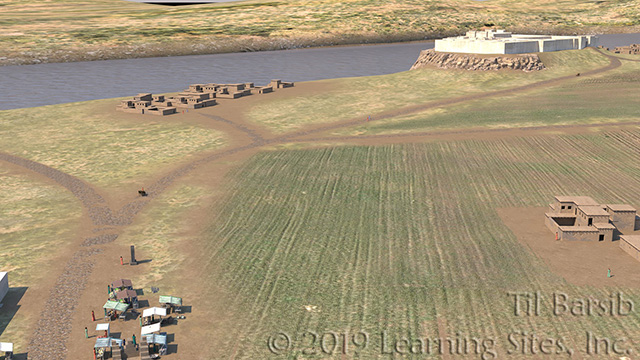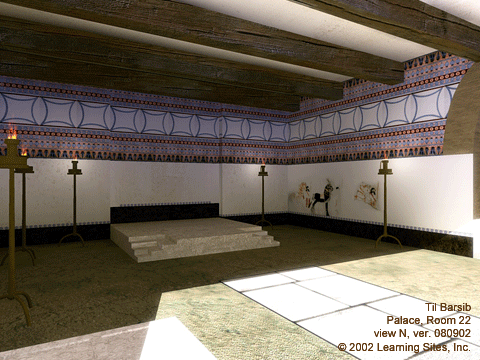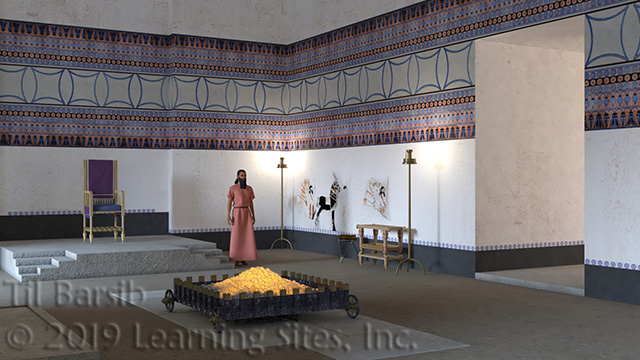Til Barsib (also spelled Til Barsip; also called Tell Ahmar) is located along the eastern bank of the Euphrates River, c.100km northeast of Aleppo, Syria. The site (enclosed by a D-shaped fortification wall) is situated on the edge of a terrace, on elevated ground, overlooking the alluvial plain of the Euphrates.
The pin points to the location of Til Barsib.
The site was excavated by a French team from 1929 to 1931, under the direction of François Thureau-Dangin. Rescue operations have continued at the site since 1988 under the direction of Guy Bunnens, University of Melbourne, Australia. Excavations indicate that the site has been occupied from Ubaid period onward. The site became the capital of the Aramaean kingdom of Bit-Adini in Upper Syria. It was conquered by Shalmaneser III in 856 BCE. He then renamed the site Kar Shalmaneser and built a palace on the acropolis, probably as a provincial residence. The Palace's final form is likely by Ashur-bani-pal.
Only about 88 x 132m of the Palace area has been uncovered. It was considerably larger, but much of the building has now eroded away, primarily due to encroachment by the Euphrates River. Areas beyond the Palace, notably the so-called Lion Gate (an entry through the town's encircling fortification walls along the northeast side), were also excavated by the French team. During the early 2000s, further research via satellite imagery and test excavations were undertaken by two teams, one led by John Russell and another by Guy Bunnens.
 Our 3D digital reconstructions make use of data from the original excavation report, as well as information supplied by the two new investigations (at the left is a reconstructed aerial view of the palace on its citadel and the surrounding landscape; hover over to enlarge).
Our 3D digital reconstructions make use of data from the original excavation report, as well as information supplied by the two new investigations (at the left is a reconstructed aerial view of the palace on its citadel and the surrounding landscape; hover over to enlarge).
 In 2005, Learning Sites re-created the Palace as an interactive 3D computer model as the basis for an elementary school educational package. All of the primary suites of rooms were digitally reconstructed, with digital surrogates of the wall decorations re-placed on the walls of the model using copies of the original Lucien Cavro excavation-era water colors, now in the Museé du Louvre (used with their permission; the 2005-version of the throne room reconstruction can be seen at the left; hover over to enlarge).
In 2005, Learning Sites re-created the Palace as an interactive 3D computer model as the basis for an elementary school educational package. All of the primary suites of rooms were digitally reconstructed, with digital surrogates of the wall decorations re-placed on the walls of the model using copies of the original Lucien Cavro excavation-era water colors, now in the Museé du Louvre (used with their permission; the 2005-version of the throne room reconstruction can be seen at the left; hover over to enlarge).
 In addition, the teaching package (originally created in Flash with QTVR panoramas) includes a 3D computer model of the topography of the site, a model of the Lion Gate (through the enciente wall at the northeast edge of the site), the nearby stela of Esarhaddon, and an Assyrian temple (situated to the west of the palace mound, and based on evidence from the contemporary sites of Tel Halaf and Arslan Tash). In 2019, Learning Sites updated the entire package, including reworking all the major rooms in the palace and the landscape (see the revised throne room at the left; hover over to enlarge; see the index at the top of the page for access to additional features of the site). The results of the new project were compiled into an educational video for classroom use.
In addition, the teaching package (originally created in Flash with QTVR panoramas) includes a 3D computer model of the topography of the site, a model of the Lion Gate (through the enciente wall at the northeast edge of the site), the nearby stela of Esarhaddon, and an Assyrian temple (situated to the west of the palace mound, and based on evidence from the contemporary sites of Tel Halaf and Arslan Tash). In 2019, Learning Sites updated the entire package, including reworking all the major rooms in the palace and the landscape (see the revised throne room at the left; hover over to enlarge; see the index at the top of the page for access to additional features of the site). The results of the new project were compiled into an educational video for classroom use.
Nunn, Astrid
1988 Die Wandmalerei und der Glasierte Wandschmuck im Alten Orient, Leiden: Brill.
Parrot, André
1961 The Arts of Assyria, translated by Stuart Gilbert and James Emmons, New York: Golden Press.
Thomas, Ariane
2019 Les peintures murales du palais de Tell Ahmar: les couleurs de l'Empire assyrien, Paris: Faton.
Thureau-Dangin, F. & Maurice Dunand
1936 Til-Barsib. Avec le concours de Lucien Cavro et Georges Dossin. 2 vols., Paris: Paul Geuthner.
Tomabechi, Y.
1983/84 "Wall Paintings from Til Barsip," Archiv fur Orientforschung 29/30:63-74.
as well as personal communications from and the assistance of Guy Bunnens, David Kertai, Astrid Nunn, Julian Reade, and John Russell